Cockroach infestations can be a major nuisance for homeowners in Vancouver. These resilient pests not only compromise the cleanliness of your home but also pose health risks. If you’ve decided to take action against a cockroach problem, preparing your home for treatment is crucial for maximizing effectiveness. This article outlines the steps you should take to prepare your home for a successful cockroach treatment.
Understanding the Cockroach Problem in Vancouver
Before delving into preparation, it’s important to understand why cockroaches thrive in Vancouver. The city’s mild climate, especially in urban areas, provides a conducive environment for these pests. Common species like the German cockroach and the American cockroach are often found in homes, restaurants, and other buildings. They are attracted to food sources, warmth, and moisture, making kitchens and bathrooms prime targets.
When you notice signs of an infestation—such as droppings, egg cases, or a musty odor—it’s time to act. Professional pest control services can effectively eliminate cockroaches, but proper preparation is key to ensuring the treatment’s success.
Step 1: Declutter Your Home
One of the first steps in preparing for a cockroach treatment is to declutter your living space. Cockroaches thrive in cluttered areas where they can hide and breed. Here’s how to declutter effectively:
- Clear Surfaces: Remove items from countertops, tables, and floors. This includes dishes, appliances, and decorative items.
- Organize Storage Areas: Go through closets, cabinets, and storage boxes. Remove unnecessary items and organize what remains. Consider using clear bins for easy visibility.
- Dispose of Unused Items: Throw away anything that you no longer need or use, particularly items stored in dark, hidden spaces.
Decluttering not only facilitates treatment but also makes your home less attractive to cockroaches in the future.
Step 2: Clean Thoroughly
A thorough cleaning is essential before any pest control treatment. Cockroaches are attracted to food particles and spills, so eliminating these sources will help reduce their numbers. Here’s a cleaning checklist:
- Kitchen: Clean countertops, stovetops, and sinks. Wipe down all surfaces, and be sure to clean under appliances like the refrigerator and oven. Empty and clean your pantry, discarding expired or open food items.
- Bathroom: Scrub sinks, tubs, and toilets. Remove any items from under the sink and clean that area as well.
- Living Areas: Vacuum carpets and upholstery, paying special attention to corners and under furniture. Don’t forget to clean behind large pieces of furniture, such as sofas and bookcases.
- Garbage: Take out the trash and ensure that all garbage cans are clean and sealed tightly. Use bins with lids to prevent access.
A clean environment minimizes the chances of cockroaches being attracted back after treatment.
Step 3: Seal Entry Points
Cockroaches can enter your home through the tiniest cracks and crevices. To reduce the likelihood of reinfestation, take the time to seal any potential entry points. Here’s how:
- Inspect for Cracks: Check the foundation, walls, and around windows and doors for cracks or gaps. Use caulk or foam sealant to fill these spaces.
- Repair Screens: Ensure that all window screens are intact. Replace any damaged screens to prevent cockroaches from entering.
- Check Plumbing: Look for gaps around pipes and fixtures in kitchens and bathrooms. Use plumber’s putty or silicone sealant to seal these openings.
By sealing entry points, you’ll create a barrier that helps prevent future infestations.
Step 4: Move Furniture and Appliances
For the pest control treatment to be effective, it’s important to provide easy access to all areas of your home. This may require moving furniture and appliances. Here’s what to do:
- Relocate Large Items: Move sofas, chairs, and tables away from walls to allow pest control technicians to treat the entire area.
- Clear Kitchen Appliances: Pull out refrigerators, stoves, and microwaves. Ensure that the areas behind and beneath these appliances are accessible for thorough treatment.
- Create a Clear Path: Ensure that hallways and entrances are clear of obstacles, allowing technicians to move freely throughout your home.
By providing clear access, you’ll ensure that the treatment is comprehensive and effective.
Step 5: Remove Pets and Personal Items
Pets and personal items can interfere with the pest control treatment process. To ensure their safety and the effectiveness of the treatment, consider the following:
- Relocate Pets: If possible, keep pets with a friend or family member during the treatment. If this isn’t feasible, confine them to a room that will not be treated and inform the pest control technician.
- Protect Personal Items: Store items such as clothes, toys, and bedding in sealed containers or bags. This prevents them from coming into contact with any pesticides used during treatment.
Safety is paramount, so taking these precautions will protect both your pets and your belongings.
Step 6: Inform Your Pest Control Technician
Communication with your pest control technician is vital for a successful treatment. Here’s what to discuss:
- Inform of Previous Treatments: If you’ve had pest control services before, let the technician know which treatments were used and any issues you faced.
- Share Observations: Provide details about when you first noticed the infestation, specific locations where you’ve seen cockroaches, and any other relevant information.
- Ask Questions: Don’t hesitate to ask about the treatment process, expected outcomes, and any additional preparations you should consider.
Clear communication helps technicians tailor their approach to your specific situation, increasing the likelihood of a successful outcome.
Step 7: Follow Post-Treatment Instructions
After the treatment is completed, the pest control company will provide you with instructions for maintaining a cockroach-free environment. Following these guidelines is crucial for long-term success:
- Avoid Cleaning Immediately: Do not clean the treated areas for a specified period after treatment, as this may remove the pesticide residue that works to eliminate cockroaches.
- Monitor for Activity: Keep an eye out for any signs of continued cockroach activity, such as droppings or sightings. Report any concerns to your pest control technician.
- Maintain Cleanliness: Continue to practice good sanitation habits to minimize food and water sources for cockroaches. Regularly vacuum and wipe down surfaces.
By adhering to these post-treatment instructions, you can help ensure that the treatment remains effective.
Step 8: Consider Ongoing Pest Management
Preventing future infestations requires ongoing vigilance. After the initial treatment, consider integrating pest management practices into your routine:
- Schedule Regular Inspections: Work with your pest control provider to set up periodic inspections. Regular visits can help catch any potential issues before they escalate.
- Implement Preventive Measures: Keep up with sealing entry points, maintaining cleanliness, and monitoring for signs of pests. This proactive approach will help deter cockroaches and other pests.
A long-term commitment to pest management can significantly reduce the likelihood of future infestations.
Conclusion
Preparing your home for a cockroach treatment in Vancouver is essential for achieving effective results. By decluttering, cleaning thoroughly, sealing entry points, moving furniture, and ensuring the safety of pets and personal items, you can create an environment conducive to successful pest control. Clear communication with your pest control technician and following their guidance will further enhance the effectiveness of the treatment.
Ultimately, a combination of effective treatment and ongoing preventive measures will help you maintain a cockroach-free home. With diligence and preparation, you can reclaim your space from these unwelcome pests and enjoy a healthier, more comfortable living environment.
 Diverse Perspectives: Insights & Stories Exploring Ideas, Sharing Knowledge
Diverse Perspectives: Insights & Stories Exploring Ideas, Sharing Knowledge




